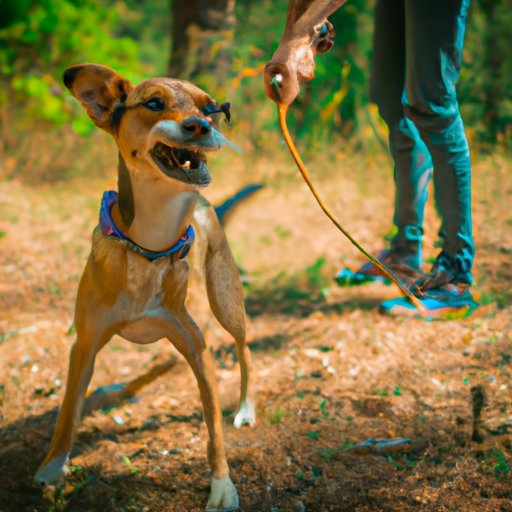
I. Introduction
Dogs are regarded as man’s best friend, but like any great relationship, both parties need to put in some effort. Training your dog is essential to foster better behavior, communication, and bonding. One of the basic commands every dog must learn is the “sit” command. In this article, we will provide an in-depth guide for teaching your dog to sit using positive reinforcement and clicker training techniques. We will also cover the benefits of training your dog to sit, breed-specific challenges, as well as tips for troubleshooting common problems.
II. Step-by-step guide on teaching a dog to sit
The “sit” command is one of the easiest commands to teach a dog, and it forms the foundation for many other commands. It’s especially useful in controlling your dog’s behavior in public spaces or when dealing with visitors. By following the steps below, teaching your dog to sit becomes incredibly easy:
- Grab some soft treats that your dog loves
- Find a quiet, distraction-free area
- Stand in front of your dog with a relaxed face and body language as well as treats held up above their nose level
- Say “sit” in a clear and firm tone while moving the treats in an upward direction. As the dog follows the upward motion, his/her rear will naturally come closer to the ground.
- Once the dog’s rear hits the ground, click and give them a treat.
- Keep repeating this procedure until the dog can sit without your assistance.
Remember, the key to success is consistency and patience. Keep training sessions short (about 5-10 mins), and don’t forget to shower your dog with encouragement and praise whenever they make progress.
III. The Importance of Using Visuals and Infographics
Using visual aids like images, videos, and infographics makes it easier for readers to comprehend and retain information. Incorporating visuals demonstrating the “sit” command in your training routine enhances engagement and entertainment for you and your dog. Pictures and videos help demonstrate the ideal posture that your dog should exhibit when sitting, as well as the correct positon of your treats and body language. An infographic can break down the process into simpler, more manageable steps – perfect for a quick reference while training your dog.
IV. Breed-Specific Challenges in Teaching Dogs to Sit
Although teaching a dog to sit is relatively simple, some breeds can prove more challenging than others. Breeds like Greyhounds and Salukis may struggle to maintain a “sit” position due to their body structure. Puppies, on the other hand, tend to have shorter attention spans and may need more frequent training sessions. To overcome these breed-specific challenges, adjust your training routine to cater to your dog’s needs. For example, shorter sessions work better for puppies, while toy breeds need smaller treats to avoid overeating. Consulting your vet or a professional trainer can also help you develop a customized training routine tailored to your breed’s needs.
V. Benefits of Teaching Your Dog to Sit
Training your dog to sit has numerous benefits beyond just mastering the “sit” command. By training your dog to sit:
- You boost your dog’s confidence and overall mental well-being.
- Public outings and visitors become more manageable as your dog exhibits better behavior.
- It becomes easier to control your dog in emergency situations, preventing them from running into danger.
- You stand a better chance of building a sustained, happy relationship with your pet as training reduces anxiety and bolsters bonding.
VI. Troubleshooting Common Problems
Training your dog can be both challenging and exhausting, and many dog owners face common problems during the process. Some dogs may become easily distracted, while others may exhibit stubborn behavior. To overcome these issues:
- Try to eliminate as many distractions as possible by training in a quiet, familiar space.
- Modify your training routine to accommodate your dog’s needs. For instance, increase rewards and praise or decrease the duration or intensity of the training sessions.
- Try to understand your dog’s personality, strengths, and weaknesses, and use them to create positive training experiences.
- Consider consulting a professional trainer or your vet for more personalized tips and guidance.
VII. Conclusion
Teaching your dog to sit is a simple yet essential skill that every dog owner must master. By following the step-by-step guide outlined in this article, reinforcing positive behavior with visual aids, addressing breed-specific challenges, and recognizing and overcoming potential issues, you can successfully train your dog to sit. Training your dog can be an incredibly rewarding experience for both you and your pet as it bolsters communication, bonding, and mental well-being. Remember, consistency, patience, and plenty of treats are key to success.




